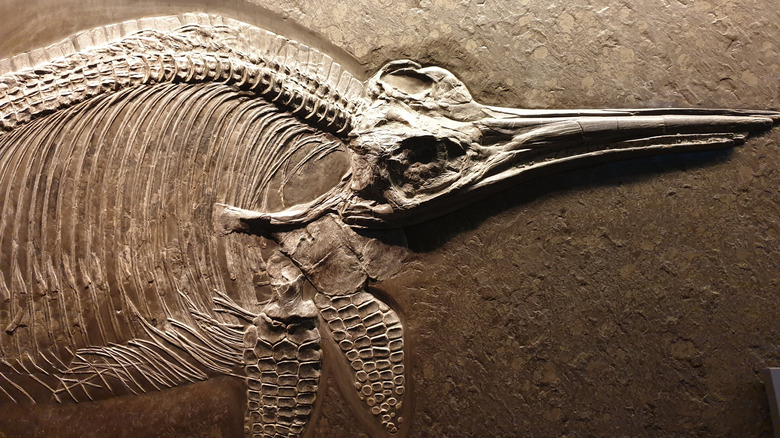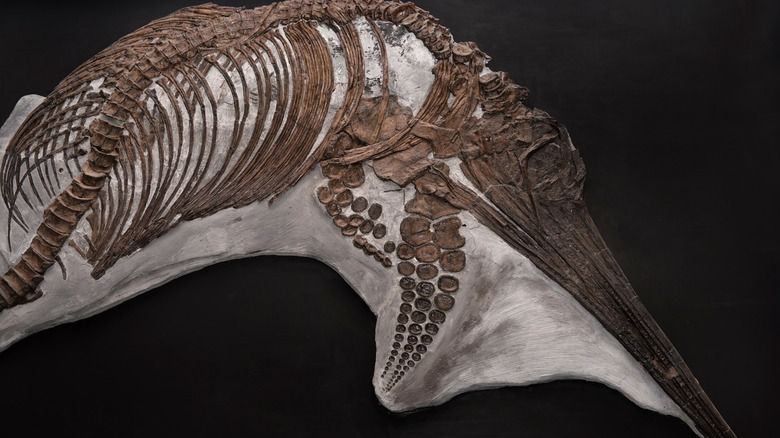Say Hello To Fiona, The Pregnant Ichthyosaur Fossil From Over 100 Million Years Ago
Between 90 million and 250 million years ago, the prehistoric waters of what is now Patagonia was home to many archaic beasts. The Ichthyosaur is one of the best-known marine reptiles of this ancient ecosystem (via Reuters). Today, the area is a Chilean glacier known as the Tyndall Glacier, which contains some well-preserved specimens of the Ichthyosaur genus, with over 70 fossils turning up in the nearby bedrock (via NASA).
The area was first surveyed in 2004 by Dr. Judith Pardo-Pérez of the Arctic Research Center, resulting in an estimated five kilometers (three miles) of fossil territory. Since the effects of climate change became more apparent, the melting glaciers revealed more fossils, expanding the range to 15 kilometers (nine miles), encompassing the Jurassic through the Cretaceous. The large number of Ichthyosaurs at the site may be because some died en masse after being trapped in a turbidity current, an oxygen-free zone that simultaneously killed and preserved the creatures (via NASA). In March of this year, "Fiona" was uncovered – a 129 to 139 million year-old complete skeleton that, to the surprise of paleontologists, held several embryos in her womb (via Physics.org).
Prehistory of Ichthyosaurs
Ichthyosaur is a genus that contains multiple species of fish-like creatures that spanned the Triassic into the Cretaceous periods (251 million to 65 million years ago). Their bodies bear similarities to both fish and modern dolphins. Although they had similar skulls, bodies, and flippers, it's believed the resemblance is an example of convergent evolution (similar traits that evolved on distinct lineages). Another marine mammal-like feature of theirs is size. Some early species were as small as dogs. Still, the discovery of 58-foot C. Youngorum told scientists that their girth expanded rapidly within the first three million years of their evolution (via Popular Science).
The diverse genus had a wide geographic range, with fossils turning up in Asia, South America, and Canada. The undulating swimmers were ambush predators that fed mainly on fish. Since they were purely aquatic, Ichthyosaurs likely gave birth in the water as whales do. But though they were an adaptive group, the asteroid impact at the end of the Cretaceous extinguished them (via Britannica). Since then, much has been reconstructed about their diet, locomotor pattern, and geography. Now the discovery of the 13-foot-long Fiona is expected to illuminate their reproductive cycle as well (via Live Science).
The Discovery of Fiona
In 2009, the Arctic Research Center came across Fiona for the first time. The first obstacle was that the site involved a 10-hour hike and thus transporting the fossil proved complicated. The logistical problems were further complicated by funding, which eventually came from the Chilean National Agency for Research and Development. With the financing finally available in 2022, a 31-day expedition was launched and led by Dr. Pardo-Pérez. Time and grant money didn't make the endeavor issue-free, however. Camping, harsh weather, pumas, and cutting and drilling the ice around the site became difficult (via Physics.org).
In this case, the arduous side of science proved fruitful. Dr. Pardo-Pérez said of the discovery (via Physics.org), "At four meters long, complete, and with embryos in gestation, the excavation will help to provide information on its species, on the paleobiology of embryonic development, and on a disease that affected it during its lifetime." They named the important find "Fiona" after the female ogre in "Shrek," since the prehistoric fish was coated in an oxide which gave it a green hue.
The 13 years it took to draw Fiona from her icy grave should prove worth it, as she will hopefully reveal more about Ichthyosaurs and the oceans of her time (via Live Science).


